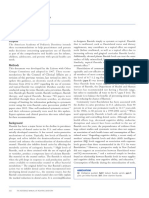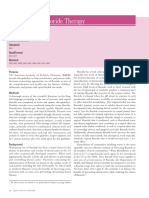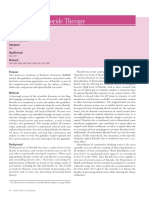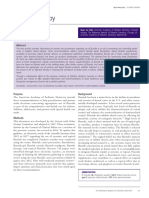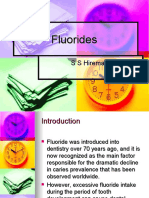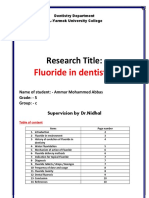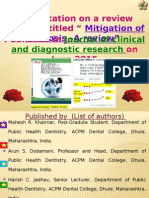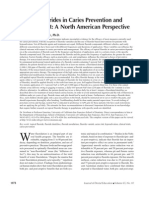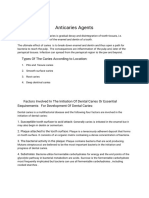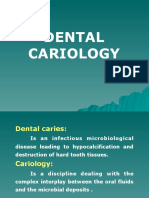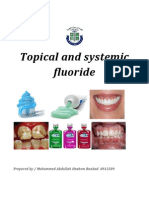Intraoral Fluoride-Releasing Devices: A Literature Review
Intraoral Fluoride-Releasing Devices: A Literature Review
Uploaded by
manikantatssCopyright:
Available Formats
Intraoral Fluoride-Releasing Devices: A Literature Review
Intraoral Fluoride-Releasing Devices: A Literature Review
Uploaded by
manikantatssOriginal Title
Copyright
Available Formats
Share this document
Did you find this document useful?
Is this content inappropriate?
Copyright:
Available Formats
Intraoral Fluoride-Releasing Devices: A Literature Review
Intraoral Fluoride-Releasing Devices: A Literature Review
Uploaded by
manikantatssCopyright:
Available Formats
350
JAYPEE
Ramandeep Singh Gambhir et al
REVIEW ARTICLE
Intraoral Fluoride-Releasing Devices: A Literature Review
Ramandeep Singh Gambhir, Daljit Kapoor, Gurminder Singh, Jagjit Singh, Heena Kakar
10.5005/jp-journals-10015-1188
ABSTRACT
Dental caries still continues to be a problem for majority of the
individuals and it can be a serious problem for medically
compromised, developmentally disabled and elderly individuals.
Water fluoridation, systemic and topical fluorides are used for
past many years to supply supplemental fluoride in order to
combat dental caries. The latest fluoride research is investigating
the use of slow-release devices for the long-term intraoral
provision of fluoride. The present review addresses two main
types of intraoral fluoride-releasing devices like the copolymer
membrane device, glass device containing fluoride and some
variations of these devices. These devices can significantly
increase the salivary fluoride concentration without substantially
affecting the urinary fluoride levels. A significant number of
studies have confirmed that intraoral fluoride-releasing devices
have great potential for use in preventing dental caries in
children, high-caries-risk groups, and irregular dental attenders
in addition to a number of other applications. As most of the
studies done on these devices are in vitro and in vivo studies,
more well-designed clinical trials are necessary to evaluate the
results so that these devices can be used clinically.
Keywords: Dental caries, Fluoride, Intraoral, Devices,
Prevention.
How to cite this article: Gambhir RS, Kapoor D, Singh G,
Singh J, Kakar H. Intraoral Fluoride-Releasing Devices: A
Literature Review. World J Dent 2012;3(4):350-354.
Source of support: Nil
Conflict of interest: None declared
INTRODUCTION
Dental caries is one of the most common diseases occurring
in humans which is prevalent in developed, developing and
underdeveloped countries and is distributed unevenly among
the populations.
1-4
More than 60% of the children aged from
5 to 17 years in the United States have decayed, missing or
filled permanent teeth because of dental caries.
5
In
epidemiological surveys in Scotland, it has been seen that
50% of the disease can be accounted for by including only
11% of 5-year-old and only 6% of 14-year-old.
6
Currently
various caries preventive strategies are in use like oral health
education, chemical and mechanical control of plaque but
fluoride (F), an efficient functional ingredient has been
shown to be most effective not only in the prevention of
caries
7-9
but also in reversal and remineralization of enamel
lesions.
10-13
There are number of ways for administering
supplemental fluoride including the fluoridation of drinking
water, the ingestion of fluoride tablets or liquids, the
incorporation of fluoride into mouth washes, dentifrices and
foods, the topical application of fluoride solutions, gels and
varnishes. These have a variable effect on caries which can
be unpredictable on an individual basis and is dependent
on patient compliance in following the prescribed regimen.
Several of these have been the subject of various Cochrane
reviews.
14,15
The history of the importance of fluoride in caries control
can be divided into two phases: Before its use for water
fluoridation in the 1950s, and before the widespread use of
fluoride dentifrices in the 1980s. Today, there is consensus
that the predominant effect of fluoride is not systemic, pre-
eruptively changing enamel structure, but mainly local,
interfering with the caries process. Hence, fluoride must be
present in the right place (biofilm fluid, saliva) and at the
right time (sugar exposure) to interfere with deminerali-
zation and remineralization events. For this effect, even sub-
ppm values of available fluoride are effective.
16
Thus,
frequent applications of topical fluoride are advised to
maximize the effects of preventive regimes. Therefore any
method of fluoride use, to be effective, should be able to
maintain a constant fluoride concentration in the oral
environment.
The purpose of this review is to explore various types
of intraoral fluoride-releasing devices (IFRD) similar to the
ones used for birth control, treatment of glaucoma and
prevention of motion sickness which can provide constant
low levels of fluoride in saliva in order to control the
incidence of dental caries in high-risk individuals. The most
important point for preferring controlled release systems to
conventional fluoride applications is their ability to increase
salivary fluoride levels without substantially increasing
serum and urinary fluoride concentrations during the
treatment period.
17
Various Methods of Fluoride Application in
High-Risk Individuals
Any method of fluoride application in high-risk individuals
should adhere to the properties that are listed in Table 1.
18
Most of the presently available methods have some
limitations and do not satisfy all the criteria and most of
them rely on patient compliance and do not release fluoride
on long-term basis.
Types of Intraoral Fluoride-Releasing Devices
The various types of intraoral fluoride-releasing devices
described in the present review are:
Copolymer membrane device
Glass device containing fluoride
World Journal of Dentistry, October-December 2012;3(4):350-354
351
WJD
Intraoral Fluoride-Releasing Devices: A Literature Review
Hydroxyapatite-Eudragit RS 100 diffusion controlled
fluoride system
Slow-fluoride release tablets for intrabuccal use.
Copolymer Membrane Device
This type of slow-release intraoral fluoride release device
(IFRD) was developed in USA.
19
This consists of a small
pellet which could be attached on or near the tooth surface.
This system was designed as a membrane-controlled
reservoir type and has an inner core of hydroxyethyl
methacrylate (HEMA)/methyl methacrylate (MMA)
copolymer (50:50 mixture), containing a precise amount of
sodium fluoride (NaF). This core is surrounded by a 30:70
HEMA/MMA copolymer membrane which controls the rate
of fluoride release from the device.
20
When the matrix
becomes hydrated, small quantities of granulated NaF are
diluted until the matrix itself becomes saturated. The precise
water absorption rates by the inner and the outer cores
enables the devices to act accurately and reliably as a release
controlling mechanism. Once placed inside the mouth, the
IFRD becomes hydrated with saliva and its characteristics
lead it to release a constant rate of sodium fluoride of 0.02
to 1.0 mg per day for up to 4 or 6 months, depending upon
the size of the device.
21
The standard form of the device is approximately 8 mm
in length, 3 mm in width and 2 mm in thickness
22
as shown
in Figure 1 and is usually attached to the buccal surface of
the first permanent molar by means of stainless steel
retainers that are spot welded to plain, standard orthodontic
bands
23
or are bonded to the tooth surfaces using adhesive
resins.
24
A new IFRD holder known as CIPI made of
biocompatible elastic alloy is specifically designed for
orthodontic patients and consists of a retentive four wire
cage provided with a cannula and a clasp. The cage contains
the IFRD, and is secured by the cannula and a clasp to the
molar tube.
21
Glass Device Containing Fluoride
Initially, the glass device that could contain inorganic
radicals was developed for use in animal husbandry to
combat pasture and feed deficiencies of various trace
elements, such as selenium, copper and cobalt.
25
Due to the
association of a number of trace elements with caries
inhibition, a modification of this device was developed in
Leeds, United Kingdom, for use in dentistry in order to
evaluate its caries preventive effects.
26
The fluoride glass
device dissolves slowly when moist in saliva, releasing
fluoride without significantly affecting the devices
integrity.
The original device was dome shape, with a diameter of
4 mm and about 2 mm thick
26-28
being usually attached to
the buccal surface of the first permanent molar using
adhesive resins. Due to the low retention rates of the original
device, it was further substantially changed to a kidney-
shaped device, being 6 mm long, 2.5 mm in width and
2.3 mm in depth, and it was proven to be effective regarding
both fluoride release and retention rate.
29
A new
modification was introduced, in order to facilitate device
handling, attachment and replacement. This new device has
been shaped in the form of a disk that is placed within a
plastic bracket, so a new device can be easily installed
without the need for debonding, removing remnants of
composite resin and performing a new acid etch and bonding
the device.
Hydroxyapatite-Eudragit RS 100 Diffusion
Controlled fluoride System
This is the newest type of slow-release fluoride device, which
consists of a mixture of hydroxyapatite, NaF and Eudragit
RS 100; it contains 18 mg of NaF and is intended to release
0.15 mg fluoride/day. It was demonstrated that
hydroxyapatite-Eudragit RS 100 matrix tablets increased the
salivary fluoride concentrations at optimal caries preventive
levels while urinary fluoride concentrations were kept at an
acceptable level in a 1-month treatment period.
30
Not much
information is available in the literature about this device.
Slow-Fluoride Release Tablets for Intrabuccal Use
Controlled release fluoride delivering system for intrabuccal
use was developed, permitting to reach high enough local
concentrations for desirable therapeutic effect with minimal
Table 1: Requirements of the ideal application method to
impart fluoride
1. Safe to administer
2. Cheap and cost-effective
3. Easily manufactured
4. Easy and quick in application
5. Robust
6. Long-term fluoride release
7. Continuous intraoral availability of fluoride
8. Acting topically at the tooth surface
9. Not relying on patient compliance
10. Preventing dental caries clinically
Fig. 1: Diagrammatic cross-sectional view of the copolymer device
which was initially 8 mm in length, 3 mm in width and 2 mm in
thickness
352
JAYPEE
Ramandeep Singh Gambhir et al
side effects. Tablets of 160 to 200 mg were formulated which
were intended to be fixed on a tooth. These tablets have a
granular matrix composed of pure hydroxyapatite, Eudragit
and/or ethylcellulose. NaF is added either by a mechanical
mixing or an impregnation method.
31
Such a mode of
fluoride administration can be extended to all chronic
pathologies of the buccal cavity.
Various Applications of Intraoral
Fluoride-Releasing Devices
Prevention of Caries
The most important function of intraoral fluoride-releasing
devices is the prevention of caries by significantly increasing
the salivary fluoride levels for a prolonged period of time.
According to the results of the study conducted on 174
children in England, the test group developed 67% fewer
new carious teeth after 2 years of placement of the devices.
26
Some authors suggested that the low fluoride levels in saliva
allow the slow mineral uptake in the base of the carious
lesion, and not only on enamel surface, as frequently occurs
when high fluoride vehicles are applied.
32
Another study
reported that there were 55% fewer new occlusal fissure
carious cavities, showing that occlusal surfaces were also
protected by these intraoral devices.
33
The copolymer
membrane device was also shown to be a similar effect on
enamel remineralization and fluoride uptake when compared
to a fluoridated chewing gum.
34
Prevention of Root Caries
Fewer studies have been conducted to demonstrate the
preventive effect of fluoride-releasing devices in root caries.
In situ studies demonstrated that the use of a slow-release
fluoride device was able to increase fluoride uptake in root
specimens (with subsurface lesions) to a higher extent when
compared to fluoridated mouthrinses and dentifrices
35
and
a fluoridated chewing gum.
36
Further studies in this regard
are needed to establish a preventive role of these fluoride-
releasing devices in the control of root caries.
Medically Compromised Individuals
Dental caries is also a major problem in individuals with
special needs who are unable to maintain their oral health
because of any disease, disability and old age. Intraoral
fluoride-releasing devices have substantial potential to
inhibit caries development in populations with special needs
especially for medically compromised, developmentally
disabled and elderly individuals.
37
People of Low Socioeconomic Status
Intraoral fluoride-releasing systems can go a long way in
preventing dental caries in high-risk individuals like ethnic
groups and people of low socioeconomic status.
20
Conditions of Xerostomia and Individuals on
Irradiation Therapy
Xerostomia is often a contributing factor for both minor
and serious health problems. Patients experiencing
xerostomia from radiation therapy or cancer chemotherapy
are at particular risk of infections from normal oral flora as
well as dental caries.
38
These devices are helpful in
prevention of caries in radiation induced xerostomia patients
and in adults with head and neck cancer undergoing
irradiation therapy.
39
Orthodontic Patients
A significant problem in patients undergoing orthodontic
treatment is white spot lesion (WSL) demineralization. A
cross-sectional study found that 50% of individuals
undergoing brace treatment had a nondevelopmental WSL
compared with 25% of controls.
40
Another study found that,
even 5 years after treatment, orthodontic patients had a
significantly higher incidence of WSLs than a control group
of patients who had not had orthodontic treatment.
41
These
lesions occur in approximately 6 to 8% of subjects during
orthodontic treatment with fixed appliances.
42,43
WSL is
considered to be the precursor of enamel caries and has
been attributed to the effect of prolonged accumulation and
retention of bacterial plaque on the enamel surfaces. It is
demonstrated that a copolymer device, intended to release
fluoride for 6 months, was able to avoid the development
of WSL after 1 year of using the devices by patients under
orthodontic treatment.
21
Fluoride-Releasing Dental Materials
There are numerous dental materials from many different
manufacturers that have the ability to release fluoride to
adjacent tooth structure and into the oral environment.
44-47
Some of the known materials are fluoridated amalgams,
glass ionomer cements, resin-modified glass ionomer
cements, light cured composite resins, etc. Fluoride-
releasing dental materials provides for improved resistance
against primary and secondary caries in coronal and root
surfaces. Plaque and salivary fluoride levels are elevated to
a level that facilitates remineralization. In addition, the
fluoride released to dental plaque adversely affects the
growth of lactobacilli and mutans streptococci by
interference with bacterial enzyme systems.
48
Fluoride
recharging of these dental materials is readily achieved with
fluoridated toothpastes, fluoride mouthrinses and other
sources of topical fluoride. This allows fluoride-releasing
dental materials to act as intraoral fluoride reservoirs.
World Journal of Dentistry, October-December 2012;3(4):350-354
353
WJD
Intraoral Fluoride-Releasing Devices: A Literature Review
Toxicity and Side Effects related to
Fluoride Devices
One of the important concerns that are raised with the use
of these devices is the possibility of debonding of the
fluoride devices and subsequent swallowing which can lead
to the development of acute toxic effects in adults and
especially in children. Hence, studies were conducted to
verify the safety of these devices so that children do not
suffer from any toxic effects even if they are accidentally
ingested. Initial studies
49
conducted on dogs reported that
dogs ingested devices containing 6 months supply of
fluoride which amounted to 485 mg of fluoride following
which there were no signs of toxicity. Subsequent studies
conducted on humans
50
reported that the fluoride glass
devices were found to be entirely safe from the possibility
of developing fluoride toxicity following their ingestion
when compared with the plasma levels achieved from
swallowing one tablet of 2.2 mg of sodium fluoride. The
fluoride devices either passed through stomach or small
intestine very quickly or remain insoluble. Further clinical
studies also reported elevated fluoride concentration in
saliva but no changes in fluoride concentrations in serum
and urine of human subjects after fitting copolymer
devices.
5,24
In some studies, mucosal irritation, eythema or
small ulcers were reported as local side effects
24,51
while
some other study reported no adverse effects on the oral
studies during the period of study.
21
CONCLUSION
From the evidence accumulated from the above discussion,
it can be concluded that intraoral fluoride-releasing devices
can play a vital role in reducing dental caries in populations.
Relatively low but elevated levels of fluoride can be
maintained for prolonged periods in the oral cavity with
the use of such devices. Devices like the copolymer
membrane device and the glass device can easily be used in
children especially in the mixed dentition stage. These types
of devices seem ideal for targeting the high-caries risk
groups who are bad dental attenders with very poor oral
hygiene and motivation. In addition, it is worth mentioning
that the use of such devices is also very favorable in terms
of cost benefit and cost-effectiveness.
52
These devices can
be easily attached to the teeth, are robust and they effectively
raise the saliva fluoride concentration approaching that
deemed necessary for caries inhibition. Moreover, these
devices were found to be completely safe from the possibility
of developing fluoride toxicity in case they are accidently
swallowed or ingested. The provision of fluoride-releasing
devices for each individual must be tailor-made to suit
varying social and working circumstances. As most of the
studies evaluating the effect of slow release fluoride devices
on intraoral fluoride levels are in vitro and in situ
investigations, further well-designed clinical trials are
required to add to the evidence that these have substantial
potential in preventing dental caries.
REFERENCES
1. Brown LJ, Winn DM, White BA. Dental caries, restorations
and tooth conditions in US adults, 1988-1991. J Am Dent Assoc
1996;127:1315-25.
2. Evans CA, Kleinman DV. The surgeon general's report on
America's oral health: Opportunities for the dental profession. J
Am Dent Assoc 2000;131:1721-28.
3. Featherstone JDB. The science and practice of caries prevention.
J Am Dent Assoc 2000;131:887-99.
4. Featherstone JDB. Prevention and reversal of dental caries: Role
of low level fluoride. Community Dent Oral Epidemiol
1999;27:31-40.
5. Kula K, Kula T, Davidson W, Parker E. Pharmacological
evaluation of an intraoral fluoride-releasing device in
adolescents. J Dent Res 1987;66(10):1538-42.
6. Bonner BC, Clarkson JE, Dobbyn L, Khanna S. Slow-release
fluoride devices for the control of dental decay. Cochrane
Database Syst Rev 2006;(4):CD005101.
7. Biesbrock AR, Faller RV, Bartizek RD, Court LK, McClanahan
SF. Reversal of incipient and radiographic caries through the
use of sodium and stannous fluoride dentifrices in a clinical
trial. J Clin Dent 1998;9(1):5-10.
8. Marinho VCC, Higgins JP, Logan S, Sheiham A. Fluoride
mouthrinses for preventing dental caries in children and
adolescents. Cochrane Database Syst Rev 2003;(3): CD00284.
9. Marinho VCC, Higgins JP, Logan S, Sheiham A. Systematic
review of controlled trials on the effectiveness of fluoride gels
for the prevention of dental caries in children. J Dent Educ
2003;67(4):448-58.
10. Brown WE, Gregory TM, Chow LC. Effects of fluorides on
enamel solubility and cariostasis. Caries Res 1977;11:118-24.
11. Burt BA. The changing patterns of systemic fluoride intake. J
Dent Res 1992;71:1228-37.
12. Levy SM, Kiritsy MC, Warren JJ. Sources of fluoride intake in
children. J Pub Health Dent 1995;55:39-52.
13. Linton JL. Quantitative measurements of remineralization of
incipient caries. J Orthod Dent Orthop 1996;110:590-97.
14. Marinho VCC, Higgins JPT, Logan S, Sheiham A. Fluoride
gels for preventing dental caries in children and adolescents.
Cochrane Database of Systematic Reviews 2002, Issue 1. [Art.
No.: CD002280. DOI: ].
15. Marinho VC, Higgins JP, Logan S, Sheiham A. Fluoride
varnishes for preventing dental caries in children and
adolescents. Cochrane Database of Systematic Reviews
2002(2):CD 002280.
16. Cury JA, Tenuta LMA. How to maintain a cariostatic fluoride
concentration in the oral environment. Adv Dent Res
2008;20:13-16.
17. Whitford GM. The physiological and toxicological charac-
teristics of fluoride. J Dent Res 1990;69(special issue):539-49.
18. Toumba KJ. Slow-release devices for fluoride delivery to high-
risk individuals. Caries Res 2001;35:10-13.
19. Cowsar D, Tarwater O, Tanquary A. Controlled release of
fluoride from hydrogels for dental applications apud Andrade
354
JAYPEE
Ramandeep Singh Gambhir et al
JD. Hydrogels for medical and related applications. Am Chem
Soc 1976;31:180-97.
20. Pessan JP, Al Ibrahim NS, Bauzalaf MAR, Toumba KJ. Slow-
release fluoride devices: A literature review. J Appl Oral Sci
2008;16(4):238-44.
21. Marini I, Pelliccioni GA, Vecchiet F, Bonetti A, Checchi L. A
retentive system for intra-oral fluoride release during orthodontic
treatment. Eur J Orthod 1999;21:695-701.
22. Mirth DB, Adderly DD, Amsbaugh SM, Monell-Torrens E, Li
SH, Bowen WH. Inhibition of experimental dental caries using
an intraoral fluoride-releasing device. J Am Dent Assoc
1983;107(1):55-58.
23. Andreadis GA, Toumba KJ, Curzon MEJ. Slow-release fluoride
glass devices: In vivo fluoride release and retention of the devices
in children. Eur Arch Paediatr Dent 2006;7(4):258-61.
24. Mirth DB, Shern RJ, Emilson CG. Adderly DD, Li SH, Gomez
IM. Clinical evaluation of an intra-oral device for the controlled
release of fluoride. J Am Dent Assoc 1982;105(5):791-97.
25. Curzon MEJ, Toumba KJ. In vitro and in vivo assessment of a
glass slow fluoride releasing device: A pilot study. Br Dent J
2004;196(9):543-46.
26. Toumba KJ, Curzon MEJ. Slow-release fluoride. Caries Res
1993;27:43-46.
27. Toumba KJ, Curzon MEJ. Fluoride concentrations in saliva
related to dental caries in primary teeth. Eur J Paediatr Dent
2001;2:15-19.
28. Toumba KJ, Curzon MEJ. A clinical trial of a slow-releasing
fluoride device in children. Caries Res 2005;39:195-200.
29. Andreadis GA, Toumba KJ, Curzon MEJ. Slow-release fluoride
glass devices: In vivo fluoride release and retention of the devices
in children. Eur Arch Paediatr Dent 2006;7(4):258-61.
30. Altinova YB, Alaan A, Aydin A, Sanisoglu SY. Evaluation of
a new intraoral controlled fluoride release device. Caries Res
2005;39(3):191-94.
31. Diarra M, Pourroy G, Boymond C, Muster D. Fluoride controlled
release tablets for intrabuccal use. Biomaterials 2003;24;|
1293-300.
32. Corpron RE, More FG, Mount G. Comparison of fluoride
profiles by SIMS with mineral density of subsurface enamel
lesions treated intraorally with a fluoride releasing device. J
Dent Res 1992;71:828-31.
33. Toumba KJ, Curzon MEJ. Prevention of occlusal caries using
fluoride slow-releasing glass devices. J Dent Res 1998;77:1017.
34. Wang C, Corpron RE, Lamb WJ, Stracham DS, Kowalski CJ.
In situ remineralization of enamel lesions using continuous
versus intermittent fluoride application. Caries Res 1993;27:
455-60.
35. Corpron RE, More FG, Beltran ED, Clark JW, Kowalski CJ. In
vivo fluoride uptake of human root lesions using a fluoride-
releasing device. Caries Res 1991;25(2):158-60.
36. Santos R, Lin T, Corpron E, Beltran D, Strachan S, Landry A.
In situ remineralisation of root surface lesions using a fluoride
chewing gum or fluoride releasing device. Caries Res
1994;28:441-46.
37. Billings RJ, Adair SM, Shields CP, Moss ME. Clinical
evaluation of new designs for intra-oral fluoride releasing
systems. Pediatr Dent 1998;20:17-24.
38. McDonald E, Marino C. Dry mouth: Diagnosing and treating
its multiple causes. Geriatrics 1991;46:61-63.
39. Toumba KJ, Al-Ibrahim NS, Curzon ME. A review of slow-
release fluoride devices. Eur Arch Paediatr Dent 2009;10(3):
175-82.
40. Gorelick L, Geiger AM, Gwinnett AJ. Incidence of white spot
formation after bonding and banding. Am J Orthod 1982;81:
93-98.
41. Ogaard B. Prevalence of white spot lesions in 19-year-old: a
study on untreated and orthodontically treated persons 5 years
after treatment. Am J Orthod Dentofacial Orthop 1989;96:
423-27.
42. Mizrahi E. Surface distribution of enamel opacities following
orthodontic treatment. Am J Orthod 1983;84(4):323-31.
43. Artun J, Brobakken BO. Prevalence of caries white spots after
orthodontic treatment with multi-bonded appliances. Eur J
Orthod 1986;8(4):229-34.
44. Donly KJ. Enamel and dentin demineralization inhibition of
fluoride-releasing materials. Am J Dent 1994;7:275-78.
45. Eichmiller FC, Marjenhoff WA. Fluoride-releasing dental
restorative materials. Oper Dent 1998;23:218-28.
46. Leinfelder KF. Dentin adhesives for the twenty-first century.
Dent Clin North Am 2001;45:1-27.
47. Torii Y, Itota T, Okamoto M, Nakabo S, Nagamine M, Inoue
K. Inhibition of artificial secondary caries in root by fluoride-
releasing restorative materials. Oper Dent 2001;26:36-43.
48. Hicks J, Garcia-Godoy F, Donly K, Flaitz C. Fluoride-releasing
restorative materials and secondary caries. J Calif Dent Assoc
2003;31:229-45.
49. Mirth D. The use of controlled and sustained release agents in
dentistry: A review of applications for the control of dental caries.
Pharmacol Ther Dent 1980;5:59-67.
50. Toumba KJ, Curzon MEJ. Plasma fluoride levels following
ingestion of a F glass slow release device. Caries Res
1994;28:217.
51. Cain BE, Corpron RE, Fee CL, Stracham DS, Kowalski CJ.
Dose related remineralisation using intra-oral fluoride-releasing
devices in situ. Caries Res 1994;28(4):284-90.
52. Kaste LM, Selwitz RH, Oldakowski RJ, Brunelle JA, Winn DM,
Brown LJ. Coronal caries in the primary and permanent dentition
of children and adolescents 1-17 years of age: United States
1988-1991. J Dent Res 1996;75:631-41.
ABOUT THE AUTHORS
Ramandeep Singh Gambhir (Corresponding Author)
Senior Lecturer, Department of Public Health Dentistry, Gian Sagar
Dental College and Hospital, Rajpura, Punjab, India, Phone: 91-99156-
46007, Fax: 91-1762 520011, e-mail: raman1g@yahoo.co.in
Daljit Kapoor
Professor and Head, Department of Periodontics, Gian Sagar Dental
College and Hospital, Rajpura, Punjab, India
Gurminder Singh
Professor, Department of Prosthodontics, Gian Sagar Dental College
and Hospital, Rajpura, Punjab, India
Jagjit Singh
Professor, Department of Periodontics, Gian Sagar Dental College
and Hospital, Rajpura, Punjab, India
Heena Kakar
Consultant, Department of General Dentistry, Apollo Dental Centre
Chandigarh, India
You might also like
- Intraoral Fluoride-Releasing Devices A Literature ReviewDocument5 pagesIntraoral Fluoride-Releasing Devices A Literature ReviewBagis Emre GulNo ratings yet
- Terapia de Fluor AAPDDocument4 pagesTerapia de Fluor AAPDAndy HerreraNo ratings yet
- BP FluorideTherapyDocument4 pagesBP FluorideTherapyKavana SrinivasNo ratings yet
- Article Fluocaril Casals Boukpessi FALTANGRAFICASDocument20 pagesArticle Fluocaril Casals Boukpessi FALTANGRAFICASLira May LachicaNo ratings yet
- G Fluoridetherapy PDFDocument4 pagesG Fluoridetherapy PDFmirfanulhaqNo ratings yet
- G Fluoridetherapy PDFDocument4 pagesG Fluoridetherapy PDFChandrika VeerareddyNo ratings yet
- Fluoride Therapy: Latest RevisionDocument4 pagesFluoride Therapy: Latest RevisionLaura ZahariaNo ratings yet
- Fluorides in Periodontal TherapyDocument4 pagesFluorides in Periodontal TherapyNurhikmah RnNo ratings yet
- Topical Application of Fluoride and Its Anti-Cariogenic EffectDocument7 pagesTopical Application of Fluoride and Its Anti-Cariogenic Effectsintia saputraNo ratings yet
- 9-Fluoridated Vs Non Fluoridated Tooth Paste Efficacy in Caries PreventionDocument19 pages9-Fluoridated Vs Non Fluoridated Tooth Paste Efficacy in Caries Preventionleena.mostafaNo ratings yet
- Position Document Use of Fluorides in MalaysiaDocument35 pagesPosition Document Use of Fluorides in MalaysiaYeoh Wei Keong100% (1)
- 04-14-08 Application of F and CaPDocument8 pages04-14-08 Application of F and CaPvelangniNo ratings yet
- ARTICULO AMERICAN ACADEMY OF PEDIATRIC Fluoride TherapyDocument7 pagesARTICULO AMERICAN ACADEMY OF PEDIATRIC Fluoride TherapykbladimirzmNo ratings yet
- Cosmetics 08 00113Document12 pagesCosmetics 08 00113Lira May LachicaNo ratings yet
- Fluoride TherapyDocument4 pagesFluoride TherapyمعتزباللهNo ratings yet
- Topical Application of Fluoride and Its Anti-Cariogenic EffectDocument7 pagesTopical Application of Fluoride and Its Anti-Cariogenic EffectRifka Zahrotun NisaNo ratings yet
- FluoridesDocument54 pagesFluoridesNAUMAN SHAHNo ratings yet
- Advanced Drug Delivery Systems For Local Treatment of The Oral CavityDocument24 pagesAdvanced Drug Delivery Systems For Local Treatment of The Oral CavityanjaNo ratings yet
- Carie PreventionDocument13 pagesCarie Preventionatul_singh2001No ratings yet
- We Are Intechopen, The World'S Leading Publisher of Open Access Books Built by Scientists, For ScientistsDocument19 pagesWe Are Intechopen, The World'S Leading Publisher of Open Access Books Built by Scientists, For ScientistselNo ratings yet
- Topical Application of Fluoride and Its Anti-Cariogenic EffectDocument7 pagesTopical Application of Fluoride and Its Anti-Cariogenic EffectghozyelyussaNo ratings yet
- A Review of The Uses of Fluoride and Outcomes of - Dental Caries Control in SingaporeDocument5 pagesA Review of The Uses of Fluoride and Outcomes of - Dental Caries Control in SingaporeMichelleLeeNo ratings yet
- Wisdom Towards Remineralization, A Literature ReviewDocument5 pagesWisdom Towards Remineralization, A Literature ReviewIJAR JOURNALNo ratings yet
- Essay SDFDocument20 pagesEssay SDFDebasmita Datta GuptaNo ratings yet
- Flouride in Dentistry by Ammar MohammedDocument10 pagesFlouride in Dentistry by Ammar Mohammedعمار محمد عباسNo ratings yet
- A Novel Approach in Oral Fast Dissolving Drug Delivery System and Their PatentsDocument14 pagesA Novel Approach in Oral Fast Dissolving Drug Delivery System and Their PatentsnikitoNo ratings yet
- Topical Fluoride PrintDocument45 pagesTopical Fluoride PrintAmal ANo ratings yet
- Fluoride Toothpastes and Fluoride Mouthrinses For Home UseDocument11 pagesFluoride Toothpastes and Fluoride Mouthrinses For Home UsePînzariu GeorgeNo ratings yet
- Systemic FluoridesDocument18 pagesSystemic FluoridesLilly PaulNo ratings yet
- Project Final 2023 PratikDocument24 pagesProject Final 2023 PratikPratik sableNo ratings yet
- Presentation On Mitigation of FluorosisDocument67 pagesPresentation On Mitigation of FluorosisViswa NathanNo ratings yet
- Chemicals in Oral Care ProductsDocument5 pagesChemicals in Oral Care ProductsparekhtechNo ratings yet
- 1 ADA Fluoride - UseDocument5 pages1 ADA Fluoride - UseTalat SultanaNo ratings yet
- FluoridesDocument52 pagesFluoridesRahel CharikarNo ratings yet
- Adsorption of Flouride Using Nanoparticles of Aluminium OxideDocument15 pagesAdsorption of Flouride Using Nanoparticles of Aluminium OxideIsa musa100% (1)
- Notes - Preventive Dentistry Topic 4 - Introduction To FluorideDocument15 pagesNotes - Preventive Dentistry Topic 4 - Introduction To Fluoridegigibis2No ratings yet
- The Rule of Fluoride Varnish in The Prevention of Dental Caries Among ChildrenDocument6 pagesThe Rule of Fluoride Varnish in The Prevention of Dental Caries Among ChildrenTariq AzizNo ratings yet
- CCIDEN 15943 A Concise Review Regarding Erosion and Abrasion On Tooth STR 071511Document8 pagesCCIDEN 15943 A Concise Review Regarding Erosion and Abrasion On Tooth STR 071511Floria DimitriuNo ratings yet
- Oral Health Promotion and FluorideDocument42 pagesOral Health Promotion and FluorideZAWWIN HLAINGNo ratings yet
- IC Method ToothpasteDocument8 pagesIC Method ToothpasteLira May LachicaNo ratings yet
- Defluoridation Methods - ReviewDocument9 pagesDefluoridation Methods - ReviewHansa KunduNo ratings yet
- Topical Fluorides in Caries Prevention and Management: A North American PerspectiveDocument6 pagesTopical Fluorides in Caries Prevention and Management: A North American PerspectivecsryderNo ratings yet
- Anticaries AgentsDocument12 pagesAnticaries AgentsHridoyul IslamNo ratings yet
- Ijhs 5126+1 9Document9 pagesIjhs 5126+1 9hariniNo ratings yet
- BDA Fact File - FluorideDocument4 pagesBDA Fact File - FluorideAainaa KhairuddinNo ratings yet
- Fluorides in Prevention of DCDocument4 pagesFluorides in Prevention of DCDr. Shivani JadimathNo ratings yet
- Cariology FellowshipDocument70 pagesCariology Fellowshipraghh roooNo ratings yet
- MEDALLA - CariologyMidterm - Intervention and Risk AssessmentDocument9 pagesMEDALLA - CariologyMidterm - Intervention and Risk AssessmentAlthea MedallaNo ratings yet
- Fluoride: Its Role in Dentistry: Understanding Dental Caries and The Fluoride EffectDocument9 pagesFluoride: Its Role in Dentistry: Understanding Dental Caries and The Fluoride Effectfoncl brc sphNo ratings yet
- Topical Fluorides in Caries Prevention and Management: A North American PerspectiveDocument7 pagesTopical Fluorides in Caries Prevention and Management: A North American PerspectiveRohma DwiNo ratings yet
- Comparison of Short-Term in Vitro Fluoride Release and Recharge From Four Different Types of Pit-And-Fissure SealantsDocument0 pagesComparison of Short-Term in Vitro Fluoride Release and Recharge From Four Different Types of Pit-And-Fissure SealantsPascalis Adhi KurniawanNo ratings yet
- Microsoft Word - CHAPTER 5. Dental PathologiesDocument21 pagesMicrosoft Word - CHAPTER 5. Dental PathologiesElena DragomirNo ratings yet
- Non Fluoride Caries Preventive AgentsDocument45 pagesNon Fluoride Caries Preventive AgentsSalwa HegazyNo ratings yet
- Review On Fluoride Varnishes Currently Recommended in Dental ProphylaxisDocument11 pagesReview On Fluoride Varnishes Currently Recommended in Dental Prophylaxisferly auliaNo ratings yet
- 32 IJDM Rev 20200209Document5 pages32 IJDM Rev 20200209amulya.kukutlaNo ratings yet
- Topical and Systemic FluorideDocument12 pagesTopical and Systemic Fluoridemidoo47No ratings yet
- EssayDocument22 pagesEssayVinay MuppanaNo ratings yet
- Dentifrice PDFDocument16 pagesDentifrice PDFdivyarati100% (1)
- Management of Deep Carious LesionsFrom EverandManagement of Deep Carious LesionsFalk SchwendickeNo ratings yet
- Listerine Oral Health Care Program: Department of PeriodonticsDocument1 pageListerine Oral Health Care Program: Department of PeriodonticsmanikantatssNo ratings yet
- Longitudinal Studies Observing Gingival Recession - Rate of Gingival Recession - Quote StudiesDocument2 pagesLongitudinal Studies Observing Gingival Recession - Rate of Gingival Recession - Quote StudiesmanikantatssNo ratings yet
- Straumann Sla: Scientific Evidence First Edition (2011)Document36 pagesStraumann Sla: Scientific Evidence First Edition (2011)manikantatssNo ratings yet
- Eur J Orthod 2012 Yoshida 493 7Document5 pagesEur J Orthod 2012 Yoshida 493 7manikantatssNo ratings yet
- Date Work Done Charges SignatureDocument1 pageDate Work Done Charges SignaturemanikantatssNo ratings yet
- Eur J Orthod 2012 Yoshida 493 7Document5 pagesEur J Orthod 2012 Yoshida 493 7manikantatssNo ratings yet
- Determination of Optimum Adhesive Thickness Using Varying Degrees of Force Application With Light-Cured Adhesive and Its Effect On The Shear Bond Strength of Orthodontic Brackets - An in Vitro StudyDocument2 pagesDetermination of Optimum Adhesive Thickness Using Varying Degrees of Force Application With Light-Cured Adhesive and Its Effect On The Shear Bond Strength of Orthodontic Brackets - An in Vitro StudymanikantatssNo ratings yet
- 1.clinical Characteristics:: Characteristics of The Animal Model in Periodontal HealthDocument86 pages1.clinical Characteristics:: Characteristics of The Animal Model in Periodontal HealthmanikantatssNo ratings yet
- Dental Management of Patients Receiving Anticoagulation or Antiplatelet TreatmentDocument0 pagesDental Management of Patients Receiving Anticoagulation or Antiplatelet TreatmentmanikantatssNo ratings yet
- IjosDocument0 pagesIjosmanikantatssNo ratings yet
- Antibiotics in DentistryDocument3 pagesAntibiotics in DentistrymanikantatssNo ratings yet
- Motor Neuron DiseaseDocument24 pagesMotor Neuron DiseasemanikantatssNo ratings yet
- 03 DB 05Document3 pages03 DB 05manikantatssNo ratings yet
- Scatter Control & Grid UseDocument27 pagesScatter Control & Grid UsemanikantatssNo ratings yet
- ScreensDocument7 pagesScreensmanikantatssNo ratings yet


